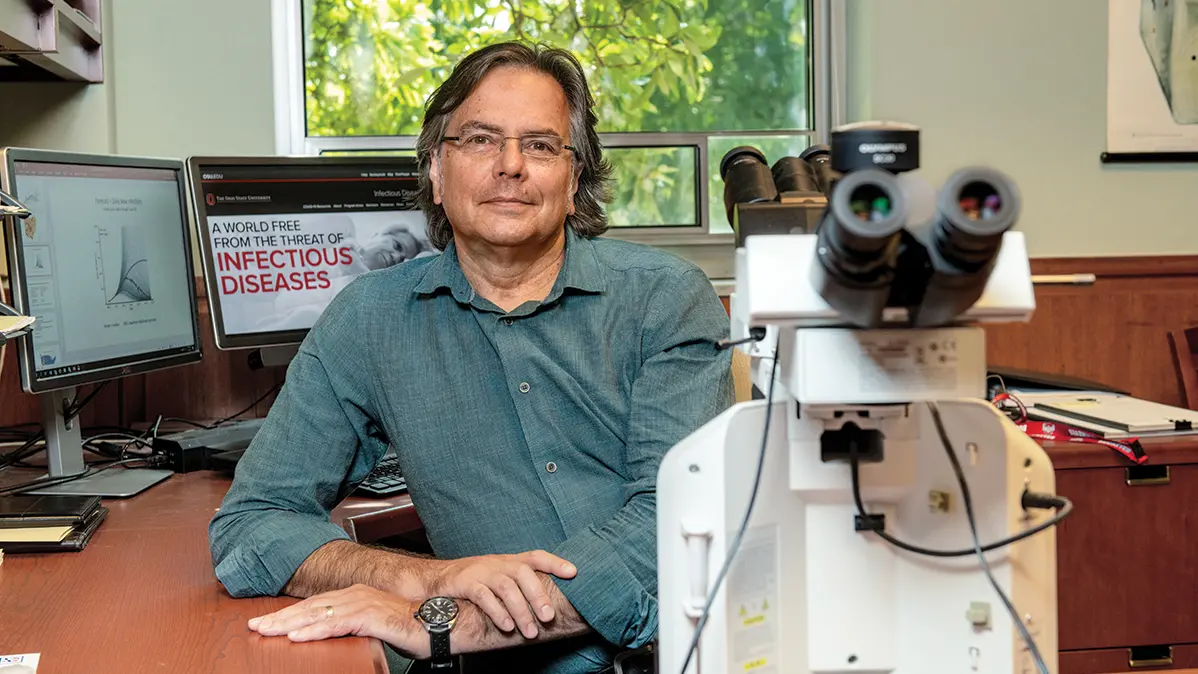Attacking COVID-19 from all angles
Researchers at Ohio State’s Infectious Diseases Institute are in search of ways to slow, treat and prevent the virus that has come to define our time.

Michael Oglesbee directs Ohio State’s Infectious Diseases Institute. (Photo by Jo McCulty)
When Michael Oglesbee ’84 DVM, ’88 PhD led the effort to establish what would become Ohio State’s Infectious Diseases Institute (IDI) in 2017, he was envisioning a threat exactly like COVID-19.
Since that threat became reality, the institute’s multi-disciplined, collaborative approach to combating disease has delivered critical information to Ohio’s public health experts and policymakers.
“COVID-19 illustrates the challenge of emerging infectious disease,” says Oglesbee, the institute’s inaugural director. “It is caused by a virus that originated in an animal reservoir and spread worldwide in less than six months, with over 25.5 million cases and 848,000 deaths as of Sept. 1.
“The IDI was formed to address the complexity and magnitude of this challenge. The diversity of relevant expertise is unprecedented.”
IDI encompasses six interdisciplinary research networks that comprise 248 faculty members from 13 colleges at Ohio State and the Abigail Wexner Research Institute at Nationwide Children’s Hospital.
The COVID-19 outbreak has led to a partnership involving the IDI, the Ohio Department of Health (ODH) and the Ohio Hospital Association to help Ohio officials and residents through a myriad of responses. We asked Oglesbee to walk us through four of the institute’s ongoing projects.

Illustration by Patrick Kastner
Predictive Modeling
In the early stages of Ohio’s COVID-19 response, IDI’s Ecology, Epidemiology and Population Health team spearheaded an effort to use predictive modeling to forecast outbreaks. Its “contact network” model showed how physical distancing could prevent initial surges.
Those models helped the state “flatten the curve” so Ohio’s health care providers could adequately manage patients with severe COVID-19 symptoms, allowing facilities to have enough hospital beds, ventilators and personal protective equipment for staff.
“The governor’s office used this to guide policy decisions, including a strategy for reopening businesses in a way that would allow us to contain new outbreaks of infection,” Oglesbee says.
Ongoing predictive modeling efforts will come from the recently formed Comprehensive Monitoring team, which draws members from IDI, ODH and Ohio State entities such as the College of Public Health, the Sustainability Institute and the Translational Data Analytics Institute.
That group will forecast the progression of infections and hospitalizations along with implementing strategies for contact tracing and containing new outbreaks. It also has informed the reopening of Ohio State’s campuses and research facilities this fall.

Illustration by Patrick Kastner
Treatment strategies
IDI’s virologists and immunologists are helping to develop a two-punch treatment that alleviates suffering for those infected and limits the virus’ contagion.
COVID-19 is highly contagious because when it enters a person’s body, it survives by replicating and shedding. The shed virus infects other people through respiratory droplets sneezed or coughed out. Once it finds a host, the virus starts in the nasal passages before taking root in the lungs. Excessive inflammatory responses in the lungs can result in severe cases of the illness.
In response, the institute’s teams are developing anti-viral drugs to block the replication that enables easy spread.
Meanwhile, to help those already battling illness, the teams are studying the immune response to create better treatments. Teams also are exploring treatments that work on other viruses along with antibody approaches that might neutralize the virus. Another study seeks to understand how many Ohioans have been infected in order to anticipate the virus’ pattern of spread.

Illustration by Patrick Kastner
Vaccine development
Many teams around the world are working furiously to develop a COVID-19 vaccine. And that’s a good thing.
“This is a trial-and-error process, making it imperative that we examine a multitude of approaches in order to establish a vaccine that is both safe and effective,” Oglesbee says.
Researchers within IDI are using their knowledge of coronaviruses, vaccine platforms, adjuvants — immune response boosters — and mucosal immunity to support both vaccine design and ways to make vaccines more effective.
“Mucosal immunity is the body’s defense in the lining of the airways — the site of infection,” Oglesbee says. “Our approach to developing a vaccine uses delivery systems that specifically enhance immune responses at this site, for example, through the use of unique delivery platforms and adjuvants.”

Illustration by Patrick Kastner
Preparing for the future
Much of what is being learned through the pandemic is helping IDI build the capacity of Ohio State and Ohio to respond to future outbreaks of other viruses.
The lessons learned are many, including how to effectively communicate infectious disease risk to the public, understanding behaviors that can contain an outbreak and studying the transmission of a virus from animals to humans.
“Understanding the mechanisms that lead to spillover events is key to preventing future human pandemics,” Oglesbee says.
The Comprehensive Monitoring team continues to build on relationships established in recent months. These ties will be invaluable in efforts to address future infectious disease outbreaks.
“We have the expertise and are building [more],” Oglesbee says. “Our efforts thus far have sweeping research and educational impacts that go beyond COVID-19.”



